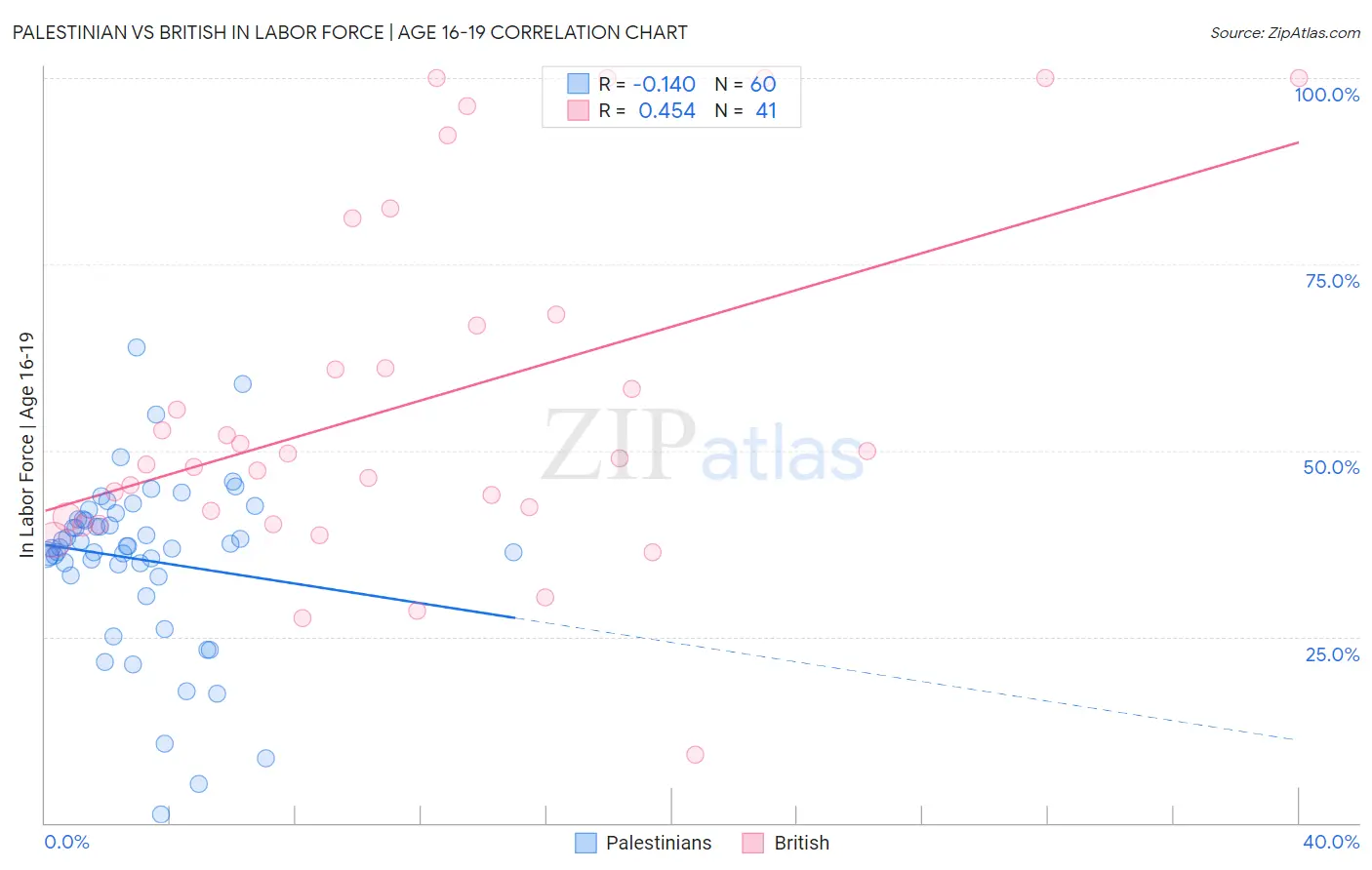Palestinian vs British In Labor Force | Age 16-19
COMPARE
Palestinian
British
In Labor Force | Age 16-19
In Labor Force | Age 16-19 Comparison
Palestinians
British
36.8%
IN LABOR FORCE | AGE 16-19
63.1/ 100
METRIC RATING
168th/ 347
METRIC RANK
40.5%
IN LABOR FORCE | AGE 16-19
100.0/ 100
METRIC RATING
55th/ 347
METRIC RANK
Palestinian vs British In Labor Force | Age 16-19 Correlation Chart
The statistical analysis conducted on geographies consisting of 216,397,857 people shows a poor negative correlation between the proportion of Palestinians and labor force participation rate among population between the ages 16 and 19 in the United States with a correlation coefficient (R) of -0.140 and weighted average of 36.8%. Similarly, the statistical analysis conducted on geographies consisting of 529,284,703 people shows a moderate positive correlation between the proportion of British and labor force participation rate among population between the ages 16 and 19 in the United States with a correlation coefficient (R) of 0.454 and weighted average of 40.5%, a difference of 10.0%.

In Labor Force | Age 16-19 Correlation Summary
| Measurement | Palestinian | British |
| Minimum | 1.1% | 9.1% |
| Maximum | 63.8% | 100.0% |
| Range | 62.7% | 90.9% |
| Mean | 35.4% | 56.2% |
| Median | 37.1% | 48.9% |
| Interquartile 25% (IQ1) | 34.0% | 40.6% |
| Interquartile 75% (IQ3) | 40.7% | 67.6% |
| Interquartile Range (IQR) | 6.8% | 27.0% |
| Standard Deviation (Sample) | 11.5% | 23.4% |
| Standard Deviation (Population) | 11.4% | 23.1% |
Similar Demographics by In Labor Force | Age 16-19
Demographics Similar to Palestinians by In Labor Force | Age 16-19
In terms of in labor force | age 16-19, the demographic groups most similar to Palestinians are Arab (36.8%, a difference of 0.030%), Immigrants from Latvia (36.8%, a difference of 0.080%), Immigrants from South Africa (36.8%, a difference of 0.14%), Immigrants from Western Africa (36.9%, a difference of 0.20%), and Yakama (36.9%, a difference of 0.21%).
| Demographics | Rating | Rank | In Labor Force | Age 16-19 |
| Cambodians | 71.5 /100 | #161 | Good 37.0% |
| Immigrants | Jordan | 69.5 /100 | #162 | Good 36.9% |
| Bermudans | 69.3 /100 | #163 | Good 36.9% |
| Immigrants | Kuwait | 68.9 /100 | #164 | Good 36.9% |
| Yakama | 66.9 /100 | #165 | Good 36.9% |
| Immigrants | Western Africa | 66.7 /100 | #166 | Good 36.9% |
| Arabs | 63.6 /100 | #167 | Good 36.8% |
| Palestinians | 63.1 /100 | #168 | Good 36.8% |
| Immigrants | Latvia | 61.6 /100 | #169 | Good 36.8% |
| Immigrants | South Africa | 60.5 /100 | #170 | Good 36.8% |
| Immigrants | Cambodia | 58.4 /100 | #171 | Average 36.7% |
| South Africans | 58.3 /100 | #172 | Average 36.7% |
| Russians | 57.5 /100 | #173 | Average 36.7% |
| Immigrants | Czechoslovakia | 50.0 /100 | #174 | Average 36.6% |
| Natives/Alaskans | 49.0 /100 | #175 | Average 36.6% |
Demographics Similar to British by In Labor Force | Age 16-19
In terms of in labor force | age 16-19, the demographic groups most similar to British are Tlingit-Haida (40.5%, a difference of 0.030%), Immigrants from Kenya (40.5%, a difference of 0.060%), Fijian (40.4%, a difference of 0.090%), Lithuanian (40.4%, a difference of 0.11%), and Aleut (40.4%, a difference of 0.13%).
| Demographics | Rating | Rank | In Labor Force | Age 16-19 |
| Icelanders | 100.0 /100 | #48 | Exceptional 40.8% |
| Cree | 100.0 /100 | #49 | Exceptional 40.8% |
| Indonesians | 100.0 /100 | #50 | Exceptional 40.7% |
| Immigrants | Zaire | 100.0 /100 | #51 | Exceptional 40.7% |
| Immigrants | Laos | 100.0 /100 | #52 | Exceptional 40.6% |
| Immigrants | Kenya | 100.0 /100 | #53 | Exceptional 40.5% |
| Tlingit-Haida | 100.0 /100 | #54 | Exceptional 40.5% |
| British | 100.0 /100 | #55 | Exceptional 40.5% |
| Fijians | 100.0 /100 | #56 | Exceptional 40.4% |
| Lithuanians | 100.0 /100 | #57 | Exceptional 40.4% |
| Aleuts | 100.0 /100 | #58 | Exceptional 40.4% |
| Slavs | 100.0 /100 | #59 | Exceptional 40.4% |
| Immigrants | Eastern Africa | 100.0 /100 | #60 | Exceptional 40.4% |
| Americans | 100.0 /100 | #61 | Exceptional 40.3% |
| Cherokee | 100.0 /100 | #62 | Exceptional 40.2% |